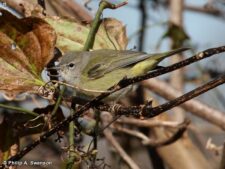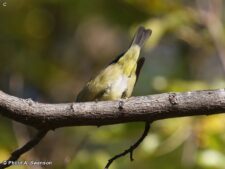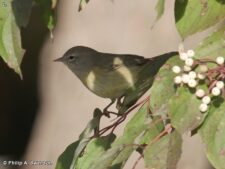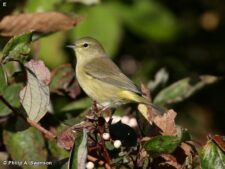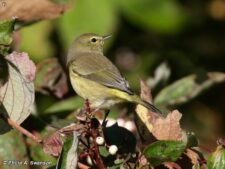
5.00 inches long. The Orange-crowned Warbler is a rather drab warbler. It has dull olive-green upperparts with an indistinct stripe through the eye causing a split eye ring. Some birds may have a rather grayish appearance on the head. The rump and uppertail coverts are brighter yellow than the rest of the upperparts. The underparts can be very pale yellow to pale olive with faint, blurry streaking on breast and sides. All forms have yellow undertail coverts. There are no wing bars or tail spots. There is an orange head patch that is seldom seen. Some first fall birds can be pale olive on the breast but will still have yellow undertail coverts. The Orange-crowned Warbler is similar to female and juvenile Yellow Warblers but the Yellow Warbler has pale edging on wings and yellow tail spots and no eye line. The Orange-crowned Warbler is also somewhat similar to the Nashville Warbler but the Nashville has clear brighter yellow underparts with no streaking. The Nashville also has a bold eye ring. Finally, the Orange-crowned Warbler is also similar to a fall plumaged Tennessee Warbler. The Tennessee has a brighter green back, no streaks on breast, and has white undertail coverts. Tennessees do not have a split eye ring.
The Orange-crowned Warbler is common in migration. Migration is spread out. It may be seen in spring from early April through late May and in the fall from early September occasionally through early November.
The Orange-crowned Warbler moves deliberately. It is a solitary warbler and forages for food along branches and in foliage low in trees, shrubs, and grasses. This warbler was sometimes called a dusky warbler. It responds to pishing. The call note is a rough “tsit”. Its song is a high-pitched abrupt trill usually trailing off towards the end.
Disclaimer: The content of NatureSearch is provided by dedicated volunteer Naturalists of Fontenelle Forest who strive to provide the most accurate information available. Contributors of the images retain their copyrights. The point of contact for this page is: Phil Swanson.

